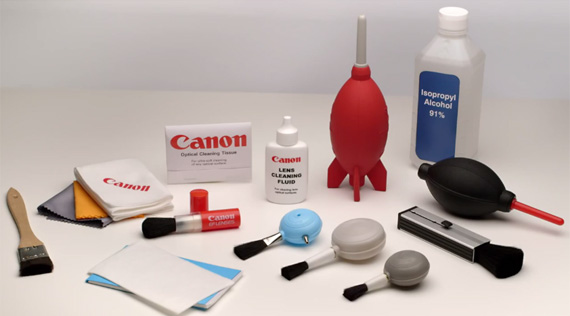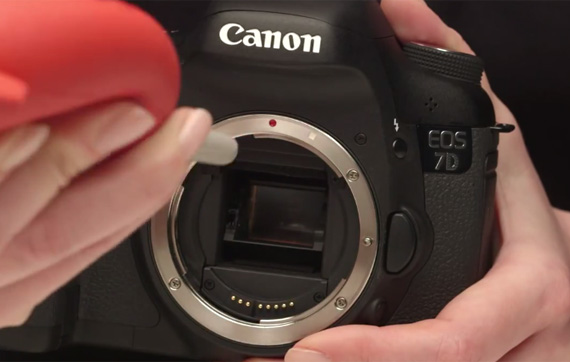Have you recently acquired a new DSLR, or are you interested in prolonging the life of the one(s) you already own? Holly from the Canon Call Center has some tips on how to keep your camera and lenses in working order in the following video:
Keeping your camera and lenses free of grit and grime can obviously improve the functionality and durability of your equipment, and as Holly says, “…when you’re confident in your equipment, you can focus on photography–and that’s what it’s all about.”
Harmful elements
- Dirt
- Dust
- Sand
- Water
- Smoke
- Extreme heat or cold
- Humidity
“But…I shoot outdoors, and am around all of that stuff all the time”, you say. It’s okay! Most cameras are built to withstand a range of conditions; some basic maintenance is all you need to keep the aforementioned bad guys at bay.
Proper Maintenance: The Goods

Camera Cleaning Supplies
In order to avoid blurry images, maintain communication between camera body and lenses, preserve functionality of zoom operation, buttons, dials, and touch screens, and keep your viewfinder view-able, start by getting a basic cleaning kit if you don’t already have one. These are a worthy investment, and are available from Canon, Nikon, and other brands; they all contain similar parts and are relatively inexpensive.
A camera bag or backpack will help to protect your equipment and ensure that your gear is ready to go when you are. Camera bags come in an endless variety of shapes and styles.
Preparation: Checking your Equipment

Keep Your Lens Contacts Clean
Before you embark on any epic photography adventure, make sure your equipment functions properly by following these steps:
- Make sure that your lenses mount smoothly and that the lens release button works easily.
- Ensure that lens contacts are smooth and shiny.
- Check lens zoom and focus rings, as well as camera body dials and switches, to make sure that they operate smoothly.
- Make sure that the hot shoe is clean and shiny, and that the pop-up flash pops up with normal tension.
- Make sure that media card is present and that it inserts smoothly.
Steps for Cleaning Your Gear

Use a Soft Bristled Brush to Remove Dust
- Remove dust and debris from the camera, lens body, and lens glass with a soft-bristled brush. If cleaning a zoom lens, extend lens to maximum length in order to clean inner barrel.
- Use a hand air blower to blow dust off of the lens and camera mirror. Do not use canned air, as the high pressure can damage your camera.
Cleaning Your DSLR Sensor

Use a Hand Air Blower for the Sensor
- Remove your lens and set your camera sensor cleaning mode to “manual cleaning”. Setting this mode will vary from camera to camera; check your user manual for instructions if you can’t find your camera’s settings on your own.
- When the sensor cleaning mode turns on and the mirror locks up, gently blow air onto the sensor using the hand air blower to remove particles. NEVER touch the sensor with your fingers or anything else, as it is very delicate.
- Turn the camera off to return the mirror to its normal position.
Cleaning Your Lens

Rubbing Alcohol
- Use a microfiber cleaning cloth to clean lens glass. Start in the center of the lens glass and move outward from the center in a circular motion.
- Use a high-grade isopropyl alcohol (91%) to clean spots and smudges from your lens glass. Apply alcohol to a lens cleaning tissue wrapped around your finger, and clean the lens glass from the center, again moving outward in a circular motion.
- Lens and hotshoe contacts as well as viewfinder may also be cleaned with isopropyl alcohol. Again, be sure to use a high-grade isopropyl, as it contains less water and will evaporate quickly.
What NOT to Do
Do not use household cleaners, paper towels, regular tissues, pencil erasers, or canned air in any part of your camera cleaning process. All of these items can damage your equipment.
Other Camera Care Tips

Prevent Drops by Attaching Your Camera Strap Properly
- When changing lenses, always point your camera body down to prevent dust and debris from settling into the opening.
- Use lens and camera body end caps when lenses are not attached to camera body.
- When moving from one extreme temperature to another, keep your camera and lenses in sealed plastic bags to prevent condensation. Allow time for equipment to adjust to temperature change before removing from the plastic bag.
- Make sure that your camera strap is attached properly; see our previous article for detailed instructions.
Did we miss anything? Share your camera care tips in the comments section below.
Like This Article?
Don't Miss The Next One!
Join over 100,000 photographers of all experience levels who receive our free photography tips and articles to stay current:






A camera bag or backpack will help to protect your equipment and ensure that your gear is ready to go when you are. Camera bags come in an endless variety of shapes and styles.
Simple and basic tips to take care of our cameras. I once destroyed my old camera lens by exposing it to direct sunlight. It’s sensors got damaged and my pictures got affected so much so that I had to dump the camera itself. Your article is concise and to the point of taking care of the DSLR camera. Will reshare this article. Thanks for the post.
I appreciate it when you suggested pointing the body of the camera down when the person is changing the lens so as to prevent debris from settling in it. I just hope that there is a way to replace the lens and the other parts that got contaminated with dust. That is the one thing that I failed to do while shooting in the desert and now I am in trouble.